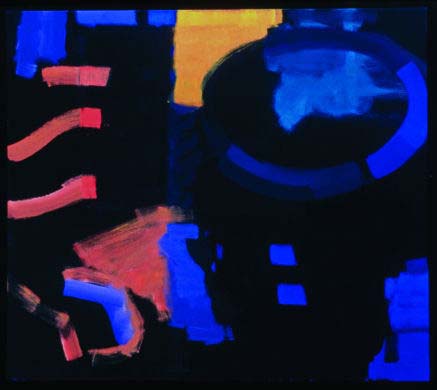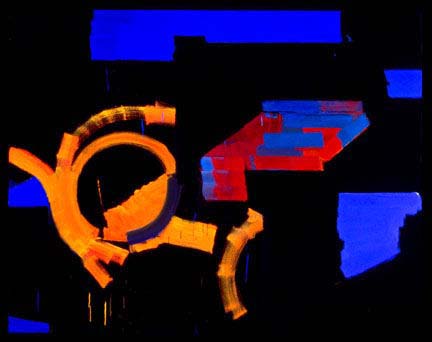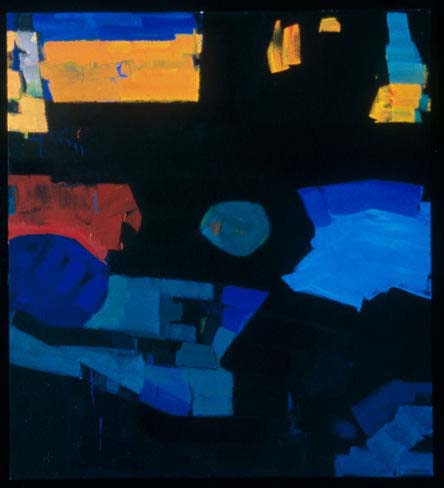The Nocturnalist
Patricia Briggs gives her read of the work of her colleague David Rich. Local Implications: Recent Painting by David Rich will be at Gallery Co through September 17.



“Local Implication: Recent Painting by David Rich” is one of those rare exhibitions where each stroke of the brush seems perfectly placed and absolutely necessary. This exhibition features lush, flawlessly composed images, which hover at the borderline between pure abstraction and keen observation of the built world. At first glance Rich’s large gestural canvases appear to be nonrepresentational, but in time their blocks of color illuminating fields of velvety black crystallize into oblique views of the industrial waterfront and urban neighborhoods folded into the night.
Two small paintings, Warehouse and Water (2005), and Warehouses and Water, Evening (2005)—the most naturalistically rendered works in the exhibition–-are dynamic images of boxy vernacular architecture seemingly observed from the window of a moving elevated train. Here, familiar horizontal silhouettes of low-rise warehouses punctuated by rectangular windows offer an image of the world as a series of familiar objects or recognizable signifiers. Rich employs a quite different representational strategy, however, in the larger canvases that make up the bulk of this show. In these paintings, abstract swatches of color and indistinct forms locate the viewer phenomenologically within the strange but familiar environment of the aging industrial cityscape without literally showing the objects that comprise these places.
Here, intuition, memory, and a kind of raw working of the senses come into play as the viewer feels his or her way into the spaces of the partially illuminated streets, bridges, and alleyways of the urban infrastructure cloaked in shadow. With a few strokes of the brush and without clearly revealing any specific things, Rich communicates the notion of wet asphalt, painted concrete, and faded brick as areas or patches of surface partially illuminated by moonlight or the darting beam of an automobile’s headlights.
In the large canvas Local Implications (about 5 feet almost-square), for example, a roughly painted rectangle of yellow-orange suggests the artificial glow of fluorescent light radiating from an isolated storefront window off in the horizon. A dark blue-green circular shape surrounded by broad strokes of flat black materializes into a patch of urban green space, just as two small bursts of fauve orange set against the dark ground register as the shimmering light of streetlight reflected off the waters of some distant canal. Remarkably, a few brushstrokes of muted violet call to mind the clapboard exteriors of Victorian homes that populate aging neighborhoods, long since overrun by the widened roadways, commercial storefronts, and warehouses of the urban expansion.
Rich’s paintings position the viewer as a pedestrian on
foot negotiating the poorly lit streets of an urban neighborhood. But sometimes the images suggest different points of view. Looking at The Internal Location of a Street in Chicago , with a broad, luminous, arching form at its center, one feels a slight vertigo, as if helicoptering in over the city, looking down at the elegant geometric forms of a highway overpass or the twirling lights of a carnival ride.
Though loose and painterly, these architectonic compositions are constructed with the same sureness of hand and intentionality that guided the welders and stonemasons that built the environments Rich celebrates in these works. Yet, these paintings do not read as social commentary or analysis of urban geography; instead they offer palpable impressions of the street that affectively locate the viewer’s body in the places that we usually just drive right through. Looking at Rich’s paintings we sense the wet, cool atmosphere of the night and see the sensual beauty of the built environment dance under a flicker of light before our eyes,